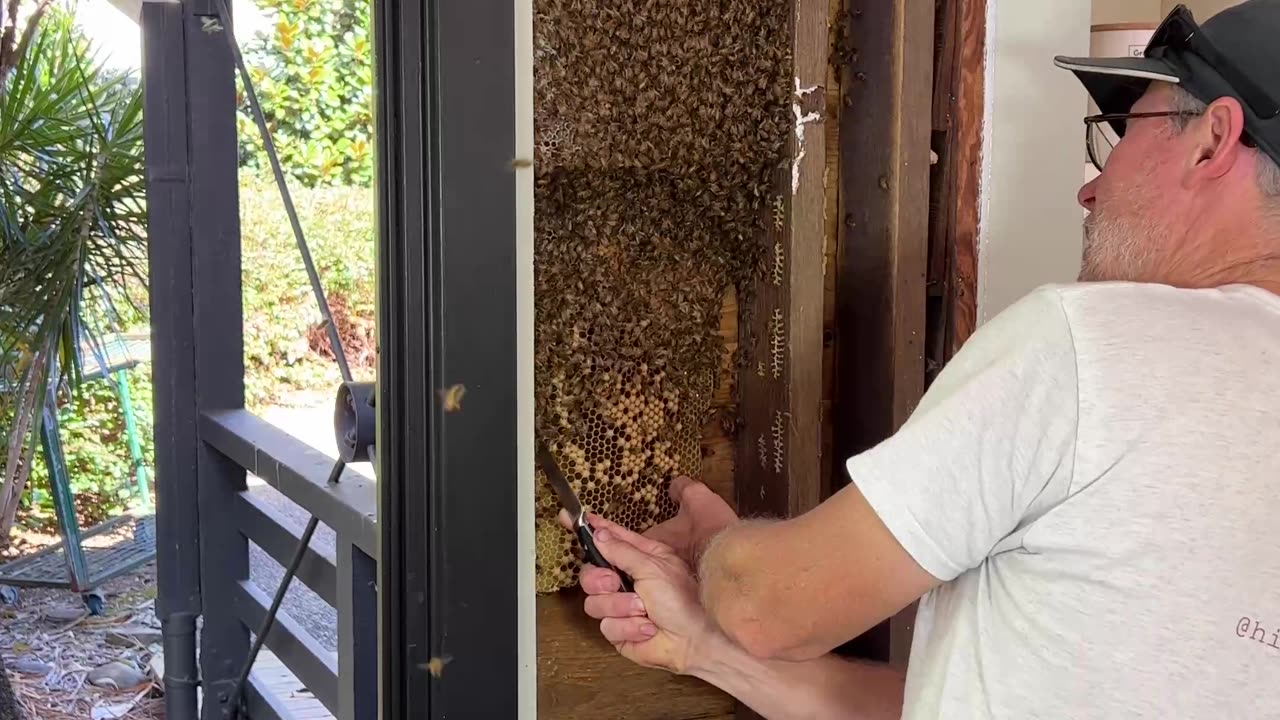Premium Only Content

Massive Beehive Rescue
Occurred on August 10, 2023 / Currumbin Valley, Queensland, Australia
Info from Licensor: When bees chewed through the wall sheeting and started coming into the room, it was time to call a professional bee remover. It is not unusual for bees to move into wall and ceiling cavities. Come springtime, their population can explode to 80,000, and they can start storing away many kilos of honey.
Scott Whitaker from Hinterland Bees removes and rescues bees for a living. He saves over 150 bee nests and swarms from buildings, houses and unwanted places every year.
Removing an established bee nest from a wall cavity involves vacuuming up the tens of thousands of bees in the search for the queen. As the bee numbers are reduced, the brood comb, which contains thousands of baby bees and the next generation, is painstakingly cut out and put into beehive frames inside the bees' new home. The honeycomb is carefully removed to be fed back to the colony at the end of the job.
Once the queen is found, she is marked with a paint marker and caged for her safety. She is then placed into her new home to wait out the removal process.
Hinterland Bees' specially designed bee vacuum does not harm the bees. They are sucked into a modified beehive box and reunited with their queen and the cut-out brood frames at the conclusion of the job.
NB. It should be noted that a regular vacuum cleaner would kill bees.
If the bees are handled carefully, they are usually gentle in return. Great care is taken not to stress, squeeze or squash them; otherwise, they will sting! Sometimes, a little smoke is required to hide their defensive pheromone, which alerts other bees to a possible threat and can trigger a stinging frenzy.
As a beekeeper, Whitaker gets stung regularly; it's all part of the job. On some bee removal jobs, he doesn't get any stings; on other occasions, he gets dozens. If he gets too many, he always has protective gear to put on.
This colony of bees numbered about 30,000 and took about 5 hours of work to remove. They were relocated to a quarantine apiary where they were monitored for pests and diseases. They are nurtured and allowed to settle into their new beehive home, where they will become a honey-producing colony under the watchful eye of a qualified beekeeper.
-
 13:00
13:00
Exploring With Nug
6 hours ago $1.11 earnedHe Went To Get A Haircut And Vanished WIthout a Trace!
44.1K2 -
 18:53
18:53
DeVory Darkins
1 day ago $8.09 earnedTrump JUST ENDED Mayor Karen Bass During HEATED Meeting
78.4K213 -
 21:06
21:06
Russell Brand
10 hours agoIT'S COMING
134K472 -
 21:26
21:26
Stephen Gardner
1 day ago🔥What JUST leaked out of Congress must be STOPPED NOW!
132K282 -
 53:25
53:25
tether
11 days agoStability and Freedom in Chaos: The Story of Tether USD₮ | Tether Documentary (USDT)
144K5 -
 56:44
56:44
VSiNLive
2 days agoFollow the Money with Mitch Moss & Pauly Howard | Hour 1
80.9K2 -
 36:50
36:50
Anthony Pompliano
2 days ago $16.44 earnedInvestors Are ALL-IN On Bitcoin
73.5K20 -
 32:19
32:19
SB Mowing
9 days agoA Backyard She’s NEVER Seen – Now Safe for the Kids to Play!
67.6K29 -
![[Day 26] CS Blast bounty baby](https://1a-1791.com/video/fwe2/8a/s8/1/Z/H/j/_/ZHj_w.0kob-small-Day-26-CS-Blast-bounty-baby.jpg) 2:09:11
2:09:11
ggezlol_tv
14 hours ago[Day 26] CS Blast bounty baby
98.2K3 -
 2:32:17
2:32:17
Sgtfinesse
13 hours ago💥Sunday Morning Hunt for Featherweight Artifact | New World PVP Server: Sclavia
98.6K4